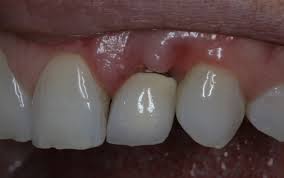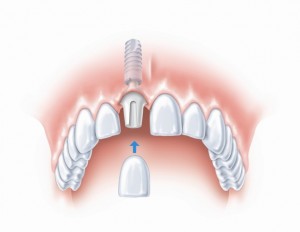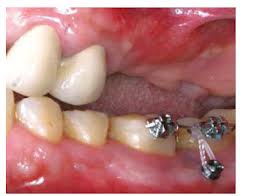It can be quite devastating to lose one or more teeth and people may feel very self-conscious about it. Fortunately dental implants have been possible for over 30 years now and have a 95%+ success rate. Patients want to be able to chew properly and feel attractive. With dental implants the missing teeth can now be replaced with something that feel natural and comfortable.
What are Dental Implants?
A Dental implant is an artificial tooth root which is surgically placed in the jaw bone to support a dental prosthesis such as a crown (artificial tooth), denture, bridge or it can ever act as an orthodontic anchor. The implant is typically made of titanium as it is biocompatible with the jaw bone and allows fusing of the bone and implant called osseointegration. Titanium is also very durable and strong.
After a tooth extraction, bone loss occurs. Dental implants help to maintain the jaw bone’s shape by preventing future bone loss. This helps to keep the natural contour of the gums above the implant. It also looks and feels much more natural than conventional dentures as it won’t shift around in the mouth when eating or talking
You mainly get two types of implants. The most common type is called endostial. It is implanted directly into the jaw and then holds one/more teeth substitutes in place. The second type is not as common. It’s called subperiosteal and is a metal frame that is placed on top of the jaw bone, below the gums. Posts then protrude through the gums to hold the prosthesis. This type can be used for patients with little jaw height or thickness.
Advantages of Dental Implants
- Comfortable fit: Implant retained crowns and even bridges and dentures feel very natural and comfortable. It functions like natural teeth. Especially people who cannot get used to conventional dentures (which often don’t fit very tight and can slip around, causing embarrassment, difficulty when eating, speaking and even sores in the mouth) will benefit greatly from implants.
- Durable and stable: Dental implants provide a more permanent and durable solution to replacing missing teeth than the alternatives. As it is very stable, it helps to maintain stability of occlusion (the way the teeth fit together). A dental implant can even be used as an orthodontic anchor as it is more stable than natural teeth.
- Great Cosmetic advantage: Implant retained teeth can look very natural, to the extent that it can be very hard to distinguish between it and natural teeth. This often boosts people’s confidence greatly as they can achieve a smile that looks even better than before they lost their teeth.
- No need to modify natural teeth: Unlike bridges, dental implants do not require any modifications to the adjacent teeth. You do not need to remove healthy tooth structure from the adjacent teeth. If the adjacent teeth are not very strong/healthy, you do not need to compromise them further by modifying them or putting extra load on them.
- Less maintenance required: Apart from maintaining very good oral hygiene, there will be very little, if any maintenance required. This can save someone a lot of trouble and visits to the dentist. In the long run you may even find that it ends up being more cost effective.
- Very high success rate: The success rate depends on many factors, but in general it is well above 90% and often as much as 98%. Good oral hygiene helps a lot to achieve a high success rate.
Disadvantages of Dental Implants
Fortunately failure and problems related to Dental implants are minimal. As with any procedure, there are some disadvantages, which I will briefly discuss. For more detail, please see my article: Dental implant problems.
- Cost: It is very expensive and unfortunately many people struggle to afford dental implants.
- Surgery required: As a surgical procedure is required to place the implant, you may expect pain, bleeding and swelling. There are also risks like nerve damage, excessive bleeding, infection and complications with anesthesia. Some of my patients, especially the elderly simply do not feel up to the surgery.
- No bone-implant integration: In rear cases, it may happen that successful osseointegration is not achieved and the implant remains loose.
- Peri-implantitis: Infection can occur later on, often due to a lack of very good oral hygiene.

Peri-implantitis
- Mechanical failures
Prerequisites to Success
Before dental implants can be placed, a thorough evaluation of the patient is needed. The person’s general health, medication used and oral health need to be accessed. The patient’s oral hygiene should be very good and the bone and gingival healthy. Smoking greatly reduces the chance of success. Smokers are statistically two and a half times more likely to have an implant fail than non-smokers.
Planning the position and number of implants is key, as the forces during chewing are significant causing a lot of stress on the implants. I would suggest that you see a specialist to place the implants as the chances of a successful outcome will be higher.
How long do Dental Implants last?
This is not an easy question to answer as there are so many factors that will influence the longevity of the implants. The first patient who had dental implants placed was Gӧsta Larsson. His implants were placed in 1965 and when he died 40 years later, the implants were still in function. If you maintain meticulous oral hygiene, visit your dentist regularly and refrain from smoking, I would say you can probably expect a lifespan of up to 20 years, maybe even longer. Unfortunately this cannot be guaranteed.
Types of Implant Restorations
- Replacement of a single tooth: One implant is used and it supports a single crown.
- Multiple tooth replacements: When multiple teeth need replacement, multiple implants are used, supporting one or more bridges. If a complete arch of teeth is needed, a minimum of 4-8 implants will be used
- Fixed and removable bridgework combined: Implants are used to support a section of fixed bridgework and a removable section is attached to it.
- Over-dentures: They place two or more standard or mini-implants which provide stability for the denture, making it more comfortable and increases functionality. The underlying bone is also preserved as there will be less resorption of the bone if the denture doesn’t press directly on the gum.
- Temporary bridgework: If a patient doesn’t want to be without teeth for any time while the implants heal, micro-mini implants can be placed to support the teeth. They will be removed once the permanent implants are healed and ready for the permanent bridgework.
- Orthodontic anchorage: Implants can provide non-movable, stable anchor units to allow easier, quicker tooth movement during orthodontic treatment.
For further information, please see the articles on:
Dental implant procedure
Dental implant cost
Dental implants problems
Leave a comment



